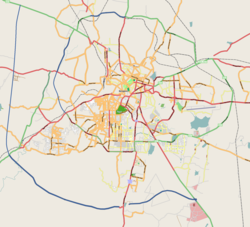| Ragigudda Sree Prasanna Anjaneyaswamy Temple | |
|---|---|
 View of the temple dome | |
| Religion | |
| Affiliation | Hinduism |
| District | Bengaluru Urban |
| Deity | Shree Prasanna Anyaneyaswamy (Lord Hanuman) |
| Festivals | Hanuman Jayanti, Ram Navami |
| Governing body | Ragiguddada Sri Prasanna Anjaneyaswamy Bhaktha Mandali Trust |
| Status | Functional |
| Features |
|
| Location | |
| Location | Jayanagara 9th Block, Bengaluru |
| State | Karnataka |
| Country | India |
| Geographic coordinates | 12°54′51″N77°35′36″E / 12.91424°N 77.59320°E |
| Architecture | |
| Type | Hindu temple architecture |
| Style | Dravidian style |
| Founder | the effort of a group of dedicated youth |
| Date established | 1972 |
| Groundbreaking | 1969 |
| Completed | 1969 |
| Website | |
| Ragigudda | |
The Ragigudda Sree Prasanna Anjaneyaswamy Temple, commonly referred to as Ragigudda Temple or Ragigudda Anjaneya Temple [1] is a temple dedicated to Lord Hanuman, spread across 5 acres also having a hillock in Jayanagara 9th Block suburb of Bengaluru, Karnataka, India. [2] The temple [3] also houses a Shivalinga along with Lord Rama, Goddess Sita, Lord Lakshmana along with the main deity of Lord Hanuman in the same precinct. The temple is on a hillock. There is a smaller temple dedicated to Lord Ganesha, Navagrahas and the Goddess Rajarajeshwari at the base of the hillock. It also plays host a Thrimurthy Sannidhi to the Hindu holy trinity of Lord Brahma, Lord Vishnu and Lord Shiva on huge engraved rocks at the side of the temple. [2]
Contents
- History
- Culture
- Timings
- Monday to Friday
- Saturday and Sunday
- Mahamangalarathi
- Gallery
- References
- External links

Currently Bengaluru's Namma Metro work is underway a few 100m from the temple with a Yellow Line Metro station planned as well. [4]






